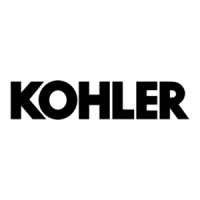
Do you have a question about the Kohler Command PRO CH750 and is the answer not in the manual?
| Compression Ratio | 8.5:1 |
|---|---|
| Cooling System | Air-cooled |
| Spark Plug | Champion RC12YC or equivalent |
| Governor Type | Mechanical |
| Oil Capacity | 2.0 U.S. qt (1.9 L) |
| Lubrication | Full Pressure |
| Max Torque | 42.4 ft-lbs (57.5 Nm) @ 2400 RPM |
| Fuel System | Carburetor |
| Ignition System | Electronic |
| Starter | Electric |
| Spark Plug Gap | 0.030 in (0.76 mm) |
| Displacement | 747 cc |
Covers major risks like fuel, exhaust, moving parts, electrical, and heat hazards.
Warning about cancer/birth defects from engine emissions.
Specific tips for starting the engine in cold conditions.
Instructions on how to properly shut down the engine.
Important limits on engine operation angle and speed to prevent damage.
A list of regular maintenance tasks and their intervals.
Guidance on suitable engine oils based on viscosity and API rating.
Procedure for verifying and maintaining the correct engine oil level.
Procedures for servicing both low-profile and heavy-duty air cleaner systems.
Instructions for cleaning the oil cooler fins and ensuring proper cooling.
Guidelines for preparing the engine for long-term storage to prevent damage.
A guide to identifying and resolving common engine problems.
Key technical data and measurements for engine models.
Covers major risks like fuel, exhaust, moving parts, electrical, and heat hazards.
Warnings related to specific engine components like crankshaft, flywheel, debris screen, and starter springs.
Precautions for safe handling and use of flammable cleaning solvents.
A list of regular maintenance tasks and their intervals.
Information on obtaining official Kohler service parts and authorized dealers.
Guidance on suitable engine oils based on viscosity and API rating.
Guidelines for preparing the engine for long-term storage to prevent damage.
Specifications for acceptable types of gasoline for engine use.
Detailed measurements and diagrams of engine dimensions with low-profile air cleaner.
Detailed measurements and diagrams of engine dimensions with heavy-duty air cleaner.
Information on locating and understanding engine model, specification, and serial numbers.
Key general specifications for various Kohler engine models.
Recommended torque values for fasteners and assembly components.
Detailed torque values for various engine components and fasteners.
Specific tolerances and clearances for engine internal parts.
Detailed internal component clearances and tolerances for engine parts.
Detailed internal component clearances and tolerances for engine parts.
Continued specifications for piston, rings, and pins clearances.
Continued specifications for piston, rings, and pins clearances.
Specifications for valves and valve lifter clearances.
Standard torque recommendations for various fastener types and grades.
List of suppliers for specialized Kohler engine service tools.
Description and part numbers for essential tools used in engine disassembly and repair.
List of approved lubricants, sealants, and greases for engine assembly.
Additional tools required for specific engine maintenance and troubleshooting tasks.
Continued list of recommended lubricants, sealants, and greases for engine assembly.
Instructions for making and using a tool to hold the flywheel during service.
Instructions for making and using a tool for rocker arm or crankshaft manipulation.
A guide to identifying and resolving common engine problems.
Troubleshooting steps for an engine that cranks but does not start.
Troubleshooting steps for an engine that starts but then stops running.
Troubleshooting steps for an engine that is difficult to start.
Troubleshooting steps for an engine that will not crank at all.
Troubleshooting steps for an engine that runs erratically or misfires.
Troubleshooting steps for an engine that fails to idle properly.
Troubleshooting steps for an engine that is overheating.
Troubleshooting steps for an engine that exhibits knocking sounds.
Troubleshooting steps for an engine experiencing a loss of power.
Troubleshooting steps for an engine consuming too much oil.
Troubleshooting steps for identifying and fixing oil leaks from seals and gaskets.
Guidance on performing a thorough external inspection of the engine before disassembly.
Procedure for testing crankcase vacuum using a manometer or gauge.
Procedure for testing cylinder sealing using a leakdown tester.
Procedures for servicing both low-profile and heavy-duty air cleaner systems.
Checks for the breather tube and importance of maintaining air cooling.
Identification of typical carbureted fuel system components.
Steps for replacing pulse and mechanical fuel pumps.
Procedures for testing fuel flow and fuel pump operation.
Diagram and list of components for the Keihin two-barrel carburetor.
Diagram and list of components for the Keihin one-barrel carburetor.
A checklist of common issues to verify before carburetor adjustment or disassembly.
Identifying common engine problems related to carburetor performance.
Steps to test the functionality of the fuel shut-off solenoid.
Explanation of the float, slow-range, and main-range circuits within the carburetor.
Instructions for adjusting low idle speed and fuel mixture.
Procedure for setting the engine's maximum high-speed RPM.
Detailed steps for disassembling and cleaning the carburetor for service.
Information on high altitude operation and required carburetor kits.
Diagram and identification of governor system components.
Instructions for initial governor adjustment and sensitivity settings.
How to adjust governor sensitivity to correct speed surging or dropping.
Explanation of electronic governor systems and their components.
Common troubleshooting scenarios for electronic governors and engine speed issues.
Diagram and identification of the engine's lubrication system components.
Step-by-step instructions for changing engine oil and filter.
Procedures for cleaning and servicing engine oil coolers.
Installation and testing procedures for the Oil Sentry™ low oil switch.
Information on spark plug inspection, component details, and service procedures.
Wiring diagram for the 15/20/25 Amp regulated battery charging system with fixed timing.
Descriptions of carbon fouled and overheated spark plugs and their causes.
Guidelines for selecting the correct battery capacity based on temperature.
General recommendations for maintaining battery health and longevity.
Description of the fixed ignition system and its components.
Wiring diagram for the charging system with variable timing SMART-SPARK™ ignition.
Description of the Smart-Spark™ system with electronic spark advance.
Wiring diagram for charging system with DSAI ignition and key switch.
Description of the Digital Spark Advance Ignition system and its components.
Wiring diagram for the 3 Amp unregulated battery charging system with 70 Watt lighting.
Procedures for testing electronic ignition systems using specialized testers.
Procedure for testing spark output on engine cylinders.
Procedure for testing ignition timing advance on DSAI and Smart-Spark systems.
Steps for testing ignition modules and their connections for DSAI systems.
Procedures for testing ignition modules and connections for Smart-Spark systems.
Important guidelines for avoiding damage to the electrical system during battery charging.
Procedure for testing the Smart Advance Module (SAM) using a tester.
Procedures for testing ASAM and DSAM modules with specific testers.
Important guidelines for avoiding damage to the electrical system during battery charging.
Information on the 15/20/25 Amp regulated charging system and stator.
Procedures for testing the rectifier-regulator unit for proper function.
Tests for charging system performance under various load conditions.
Tests for the 3 Amp/70 Watt lighting stator and charging system.
Guide to diagnosing and resolving issues related to engine starting.
Diagram, components, and service procedures for inertia drive starter systems.
Procedures for disassembling, servicing brushes/commutator, and reassembling starter motors.
Procedures for servicing solenoid shift starters, including disassembly and brush replacement.
Procedures for disassembling Delco-Remy starters, inspecting key components, and replacing brushes.
Procedures for testing the starter solenoid's pull-in coil, function, and continuity.
Diagram, components, and service procedures for retractable starter systems, including rope replacement.
Starter pawl replacement and final starter installation procedures.
Diagram and identification of components for the wet disc type clutch.
Clutch lubrication, adjustment, and reconditioning procedures.
Inspection and disassembly of the governor gear assembly.
Diagram, inspection, and reassembly procedures for Oil Pump Assembly Style A.
Steps for disassembling the Oil Pump Assembly Style A and Style B.
Procedure for removing the engine camshaft and associated parts.
Procedure for removing connecting rods, pistons, and rings from the cylinder bore.
Inspection of pistons and rings for wear, damage, and proper installation.
Specific considerations for servicing Piston Style A, including ring installation.
Specific considerations for servicing Piston Style B, including ring installation.
Procedure for correctly installing new piston rings onto the piston.
Procedure for removing the engine crankshaft from the crankcase.
Steps for removing and installing the crankshaft plug for oil passage access.
Procedure for removing the governor cross shaft from the crankcase.
Procedure for replacing the governor cross shaft oil seal.
Inspection of crankcase for gasket surfaces, bearings, and cylinder bore condition.
Details on the honing process, including crosshatch angles and stone types.
Procedures for cleaning cylinder bores after honing and measuring piston-to-bore clearance.
Accurate method for measuring piston-to-bore clearance using micrometers.
Diagram and identification of crankcase assembly components.
Procedure for installing the flywheel end oil seal into the crankcase.
Procedure for installing the governor cross shaft with correct lubrication and positioning.
Procedure for installing the crankshaft into the crankcase bearings.
Procedure for installing connecting rods, pistons, and rings into the cylinder bores.
Procedure for measuring and adjusting camshaft end play using shims.
Correct sequence for installing thrust bearings, washers, and shims for crankshaft end play control.
Details on available crankshaft end play shim thicknesses for adjustment.
Procedure for installing the closure plate oil seal to the correct depth.
Procedure for installing the closure plate, including sealant application and torque sequence.
Procedure for installing the stator and backing plates onto the crankcase.
Procedure for installing the flywheel onto the crankshaft, including key and torque specifications.
Procedure for installing the flywheel fan onto the flywheel.
Procedure for installing plastic debris screens and supports for metal debris screens.
Diagram and identification of cylinder head assembly components.
Procedure for installing hydraulic lifters, including lubrication and correct positioning.
Procedure for assembling cylinder heads, including valve components and springs.
Procedure for installing cylinder heads with correct torque sequence and specifications.
Procedure for installing push rods and rocker arms, ensuring correct positioning and torque.
Final checks of the engine assembly for proper operation and clearances.
Procedure for installing spark plugs, including gap check and torque specifications.
Procedure for installing ignition modules, ensuring correct positioning, gap, and torque.
Procedure for installing the intake manifold, including torque sequence and gasket alignment.
Diagram and identification of external engine components for reassembly.
Procedures for installing breather cover, baffles, blower housing, and associated electrical connections.
Reinstallation procedures for rectifier-regulator, SMART-SPARK module, and electric starter motor.
Procedures for installing the fuel pump and carburetor, including related connections.
Installation of governor controls, throttle/choke linkages, and Oil Sentry™ switch.
Charts detailing governor lever hole positions and RPM settings for 6mm and 8mm shafts.
Procedure for installing the control panel, throttle cable, and choke cable.
Procedure for installing valve covers, including gasket/O-ring types and torque sequence.
Procedures for installing air cleaner, muffler, oil cooler, oil filter, spark plugs, and final engine preparation.
Procedure for testing the engine on a test stand before installation into equipment.
Procedure for installing spark plugs, including gap check and torque specifications.
Procedure for installing ignition modules, ensuring correct positioning, gap, and torque.
Procedure for installing the intake manifold, including torque sequence and gasket alignment.

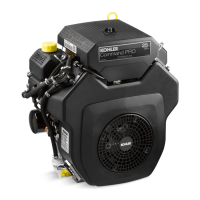
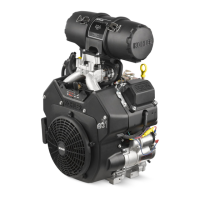




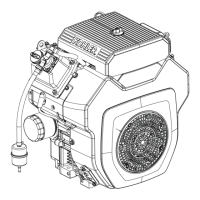
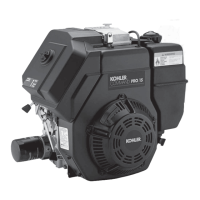
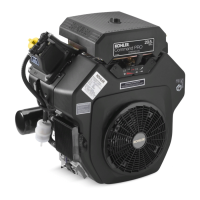

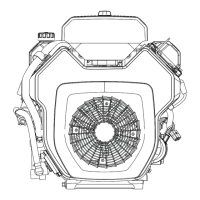
